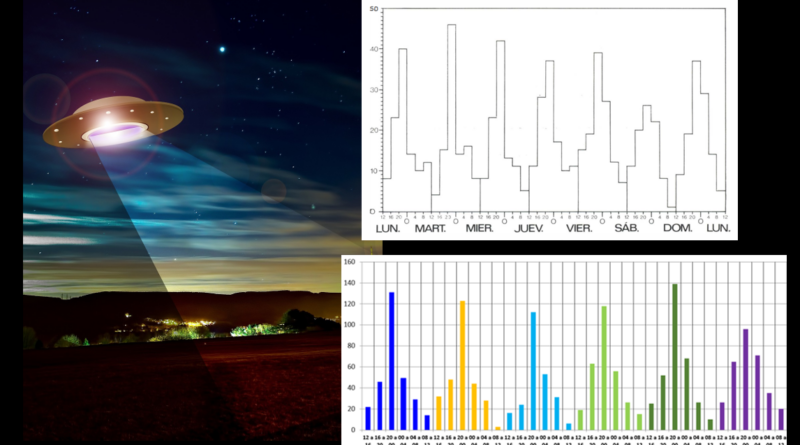UFO: INTERNATIONAL STUDIES RATIFICATION (Week Nights study)
By Carlos Ferguson (Argentina)
«Our essential task is to compile fully documented lists of observations of the phenomenon for the benefit of future scholars. So that if we fail to solve it within our generation, at least the vast amount of work done by dedicated local researchers will be preserved.» .» (DR. JACQUES VALLÉE)
“The investigative work of ufologists would never be futile: collecting with the greatest possible critical rigor all the information on the UFO phenomenon would be a valuable contribution for future generations. The work of ufologists would be equivalent to that of medieval scribes; patient copyists who preserved the Greco-Latin culture for later generations, many times without fully understanding what was transcribed». (PROF. OSCAR URIONDO)
There are many variables about the operational behavior of UFOs, which have to do with studies of flight directions, annual, monthly, hourly and many more, which include not only the perceived but also the witnesses. There are more than 60, which I have faced in each of my jobs and statistics. What Dr.Vallée and our prestigious Prof. Uriondo point out is key: to carry out international comparative studies it is essential to have a file of hundreds or thousands of cases.
After extensive work that I have done on several books, I have been able to accumulate a significant number of cases, with a rating system.
Such a sample allows evaluating an aspect that was already addressed by the most prestigious ufologist, Dr. Jacques Vallée back in 1971.
In his work “UFO ACTIVITY IN RELATION TO THE NIGHTS OF THE DAYS OF THE WEEK”, Vallée told us (synthesis):
“One of the most notable characteristics of UFO phenomena is that they occur at well-defined (but not yet predictable) time intervals. On a general scale we can observe a pattern of sudden and prominent waves of wide range, in a period of one or two months. Locally we have spikes that last from a few days to a week.»
And we also have the level of background noise, global in nature, seemingly accidental, visions that never quite disappear between waves, etc.
Although these types of surges have been studied for a long time, attention has not been paid until very recently to the distribution of observations related to time and day of the week.
In the study on the Iberian landings (QUOTE 1), our work was based on a small sample and we indicated that the frequencies of the observations were distributed «as would be expected if they were due to chance». We did not find «any pattern in this distribution that is not a reflection of the habits of potential witnesses.»
However, if we stop to consider this matter, we see that we must point out a factor that we are all forgetting: That UFO cases occur mostly at night! This means that studies on the distribution of observations in relation to «days of the week» MAY BE TOTALLY MEANINGLESS, and that; instead, these studies should be carried out on «weeknights.»
This is depicted in Fig. 2.
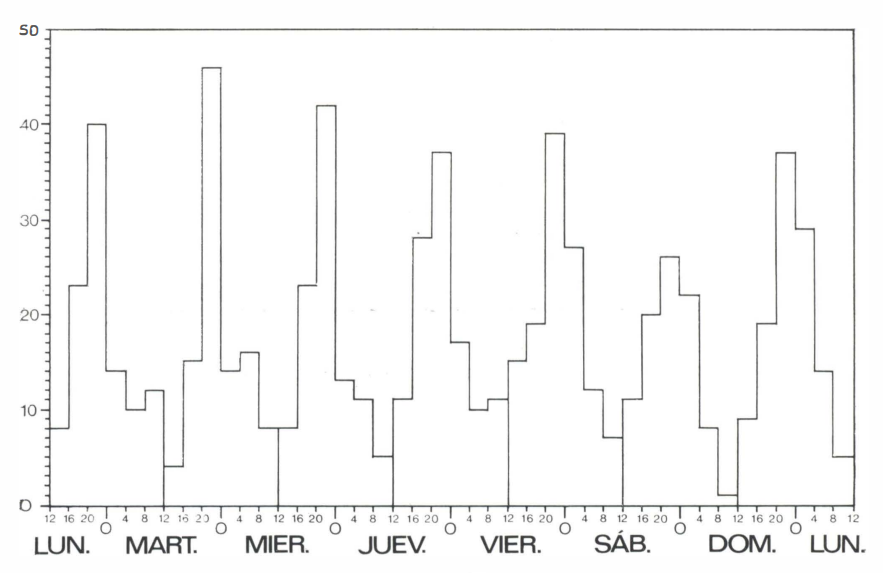
Data were obtained by counting landings listed in the Magonia catalog at four-hour intervals from 00:00 Monday to 24:00 Sunday.
But if we count the interval from noon to noon, as we think we should, the following results:
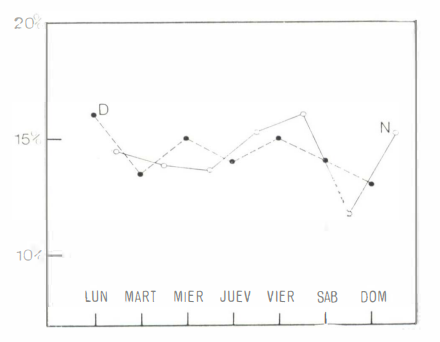
These two possible interpretations of the same data have been plotted in Fig. 3, where it can be seen that the distribution has changed considerably.
The other variations indicated by the other nights of the week do not seem incompatible with what might be expected from chance variations.
However, it would be very interesting to look at all of this in more detail, if other researchers could provide statistics based on nighttime intervals, rather than daytime ones.» (QUOTE 2)
Given that I have compiled the most important catalog of UFO cases in Argentina, and even despite the years that have passed, there is already an important basis to be able to carry out a similar study.
That’s why I focused on it, to see if the data coincides or provides any additional information to the UFO presence at night intervals.
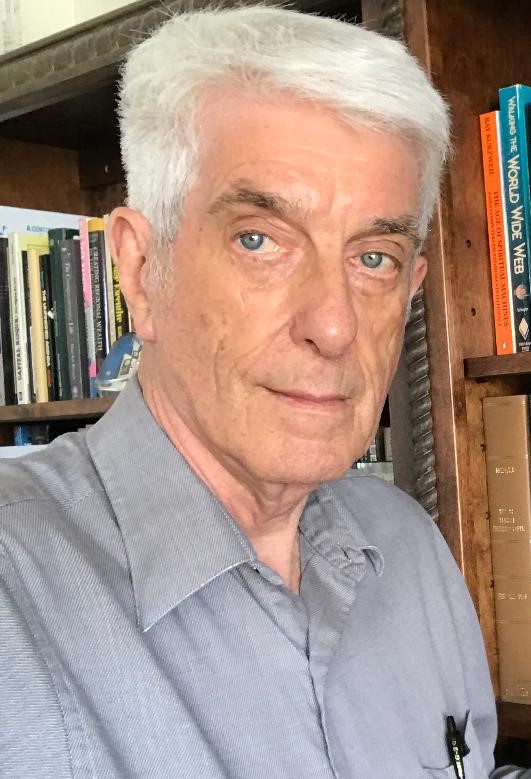
THE DATA OF ARGENTINA
For the study I have selected all the mostly positive cases that had as main data = DAY OF THE WEEK AND TIME.
First I included the annual Casuistry from 1991 to 2008, with a total of 667 data:
Year 1991 = 43 cases / Year 1992 = 9 cases / Year 1993 = 21 cases / Year 1994 = 51 cases / Year 1995 = 27 cases / Year 1996 = 23 cases / Year 1997 = 26 cases / Year 1998 = 38 cases / Year 1999 = 42 cases / Year 2000 = 57 cases / Year 2001 = 14 cases / Year 2002 = 37 cases / Year 2003 = 17 cases / Year 2004 = 37 cases / Year 2005 = 27 cases / Year 2006 = 57 cases / Year 2007 = 48 cases / Year 2008 = 93 cases
To this I added the cases with day and time of all my books, with a total of 1,387 data:
Landings in Argentina = 769 cases
Photos of UFOs in Argentina = 376 cases
Underwater UFOs in Argentina = 11 cases
UFOs in La Plata = 64 cases
UFOs in Mar del Plata = 99 cases
UFOs and Pilots in Argentina = 68 cases
The TOTAL allowed me to have a final figure of 2,054 cases
These 2054 cases are more than enough to establish a base and thus carry out the study of the nights of the days of the week in Argentina. (QUOTE 3)
I have applied the same hourly magnitude that Vallée did at the time (which covers from one noon to the next), that is:
12 to 16 hours / 16 to 20 hours / 20 to 00 hours / 00 to 04 hours / 04 to 08 hours / 08 to 12 hours. The final data yields these results:
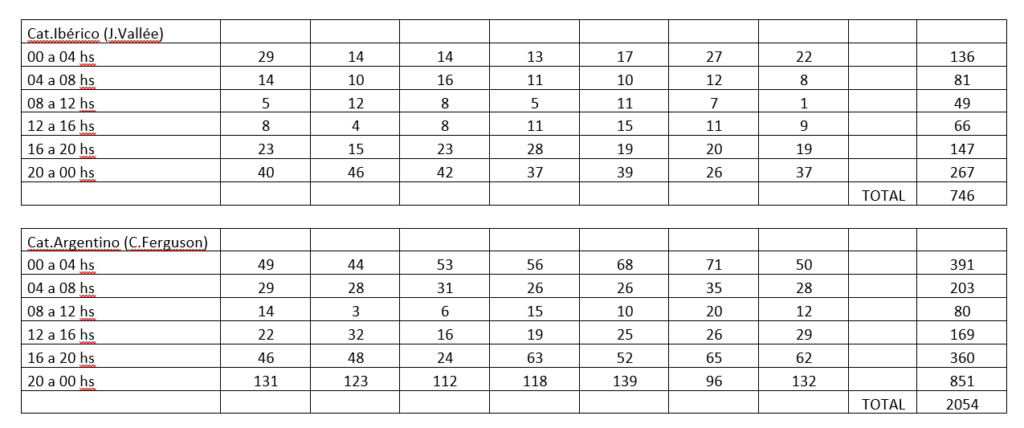
PROVISIONAL FINDINGS
Applying the system proposed by the great Dr. Jacques Vallée, that is to say: on the «nights of the week» instead of the days, we find some data that we can summarize as follows:
1- The Argentine graph of the «DAYS» of the week with respect to the «NIGHTS» of the week, presents some similarities and variations. Among the first we have the descent on «Wednesdays», and the ascent generally towards the weekend.
2 – In the Argentine study, applying what Dr.Vallée pointed out, we can see that for the NIGHTS of the week, we have a pronounced rise for Friday, balancing out for the two days of the weekend (Saturday and Sunday). The increase on Fridays coincides with studies carried out in the Old World in the 1970s and 1980s. For example, the one published by the authors David López and F.A.de Blas, who defined that «the absolute maximum occurs on Friday» (Stendek Magazine no.37 – September 1979).
3- The decrease for the day «Wednesday» had already been detected more than 40 years ago in Spain. Quotation cap. José T. Ramírez y Barberó, we could read in his 1978 study:
“It is curious that the maximums are identified with the beginning and end days of a premature and prolonged “weekend”, which is when, naturally, people hit the road leaving their usual occupations. Also, it is not surprising – without this necessarily meaning anything – that this distribution shows some signs of a rigid inverse correlation with the weekly human labor return curve. Wednesday, the day of personal maximum performance in daily work, is when «fewer UFOs» are seen, an extreme that is totally logical up to a certain point, since professional work, with its inherent problems, is soaked in the potential witness of a UFO sighting. . . and makes her unconsciously move away from these supposedly frivolous topics.( QUOTE 4)
This may have its correlation today, with many other factors.
For example: it is statistically proven that the days when the population does not travel much are Tuesdays and Wednesdays. And as we well know, the vast majority of cases occur on the roads, with witnesses moving along them.
There is nothing new about it, but it is important to see these aspects, which also have to do with the study that Ufology must do, of one of the more than 60 variables to be investigated.
All these considerations clearly have to do with sociological issues, and not specific to the phenomenon.
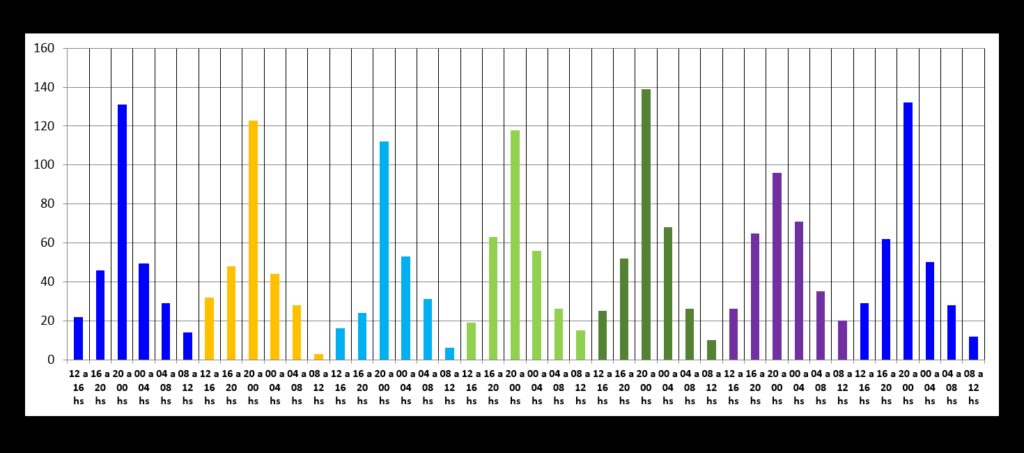
WHAT DO WE KNOW ABOUT THE REGULARITY OF UFO APPEARANCES?
Today we are clear about some things.
In the EXTENSIVE TEMPORARY activity, there is no ANNUAL periodicity, except for certain activity that occurs every little more than 24 months.
In the TEMPORARY activity (zonal FLAP), we know that it does not exceed a month or 2 months (sometimes even less, even with some constant in personal study).
Regarding MONTHLY TEMPORARY activity, there do not seem to be any definite patterns.
Regarding TEMPORARY HOURLY activity, we do have what we already discovered years ago, with the 2 most important hourly activity peaks. The phenomenon is essentially nocturnal, and only a sociological part seems to explain it. It has been maintained over time without variables.
And as for the TEMPORARY DAYS OF THE WEEK activity, there doesn’t seem to be any pattern either (although it does ratify the temporal item to the letter).
We are facing a question that could be limited to:
A – Human activity itself, with intrinsic tendencies.
B – Surely there is the influence of the news (it would be necessary to evaluate to what extent the media influence today, unlike what happened decades ago). When I refer to «influence» I do not do so in a pejorative sense, implying that the public is contaminated by a need to believe, but simply that we have more complaints on certain days of the week because there are more possible witnesses. The spread of news today is manifold.
The graph of «THE NIGHTS OF THE WEEK» perfectly shows the increase in cases towards Fridays, surely because it is the day with the greatest displacement, as indicated before. Vallée already pointed out the same thing in his study from the 70s. We see it below:
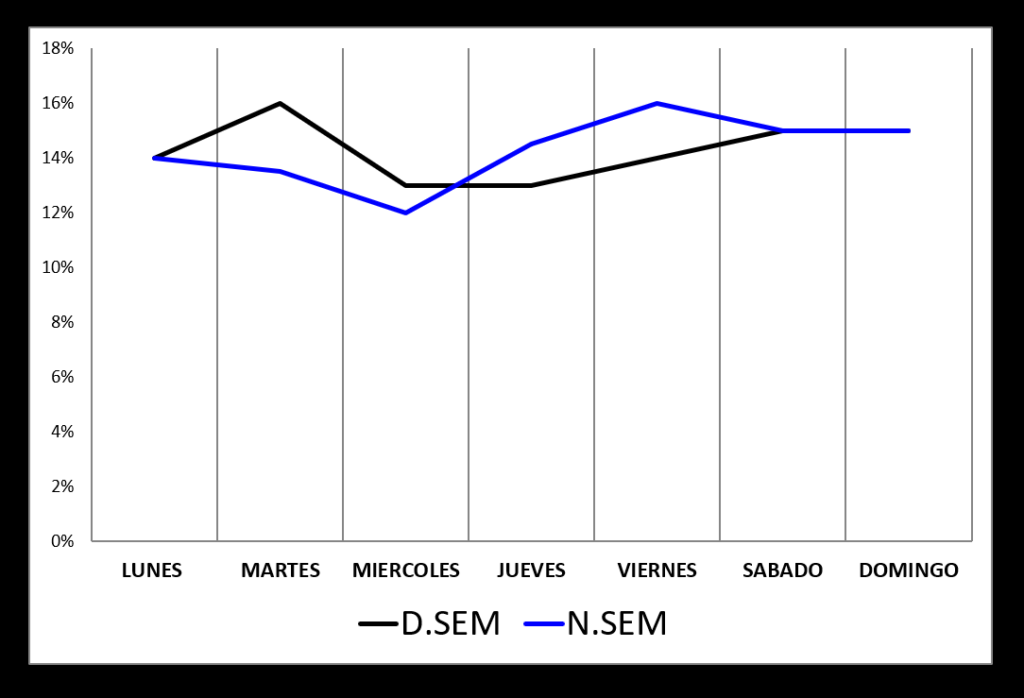
In the previous data from Argentina, we had the study conditioned on the DAYS of the week. But by doing it as Dr.Vallée recommends (starting with NIGHTS), we clearly notice in the graph above that there are differences between one study and another.
Another interesting fact is to compare the percentages of the Iberian Catalog carried out by Vallée (746 cases), with the one I have carried out (2,054 Argentine cases).
When we see both graphs (below) we can find an almost absolute similarity in the percentages of the nights of the week, which is showing us the issue of time as the main reason for this.
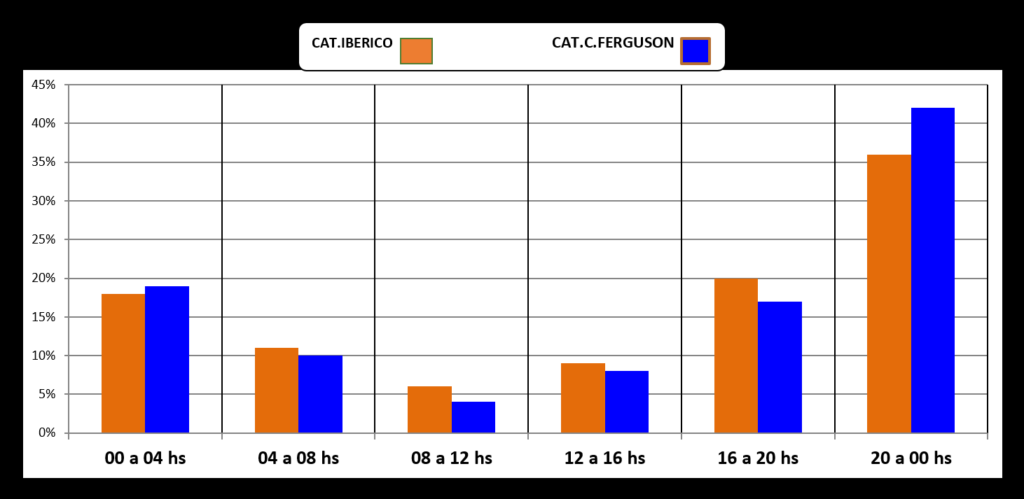
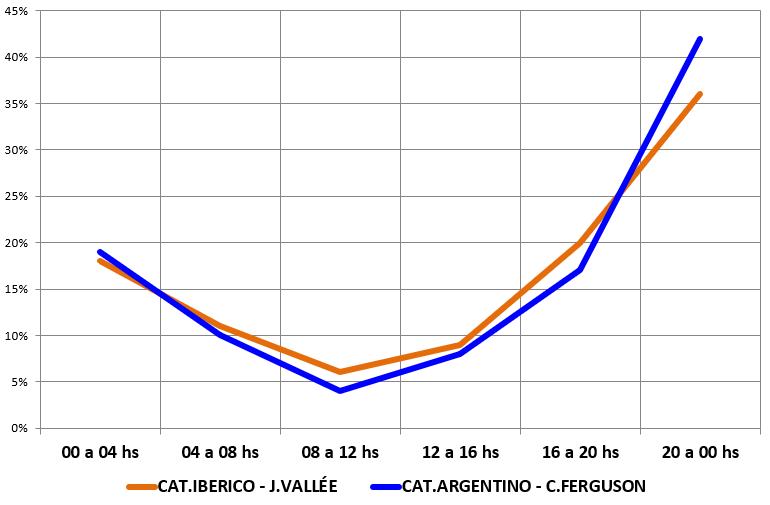
Indeed, time itself is a trend in the phenomenon, already detected decades ago, and the graphs clearly show that an Iberian catalog from the late 1960s and the Argentine study that collects historical cases up to the present are almost completely consistent.
Vallee said:
«It would be very interesting to see all of this in more detail, if other researchers could provide statistics based on nocturnal rather than diurnal intervals.»
For my part, I have been able to add this small grain of sand to the subject, with the possibility of having thousands of cases filed.
There is still much to analyze on these issues. This study by itself already required a lot of time and dedication, but it is bringing us closer to the behavior of the phenomenon, which has constants.
By the way, for some popularizers and opinion-makers of ufology these studies are irrelevant.
But ignoring some useless people who frequent ufology (as in all subjects), I find it exciting to be able to handle statistical information and compare local, regional and national data with other international ones.
Carlos Ferguson
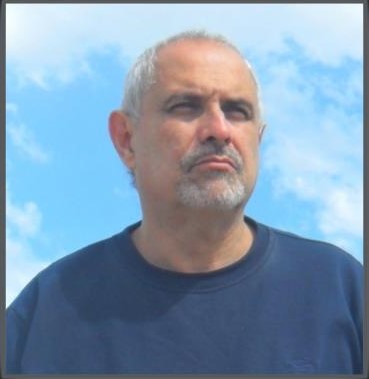
The author: He the first advisor to the Argentine Air Force (2011 to 2017) in Ufology. Carlos Ferguson works in the Logistics areas of the Ministry of Education (Province of Buenos Aires – Argentina), and administrative tasks. He is also a professor of artistic drawing and has been dedicated to researching the UFO topic for 48 years, when, being a non-believer, had a close encounter no more than 35 meters away with a disc-shaped UFO. He has courses in Satellite Technology, Remote Sensing and Geographic Information Systems. Author of 7 books and the largest compilation of landing cases in Argentina, with classified events. He has also carried out studies on cases of pilots and UFOs in Argentina, as well as underwater objects and the most recent, on the physiological and electromagnetic effects on witnesses. Hundreds of talks and notes over almost 5 decades show him with a line of work adjusted to the parameters of statistics.
For its reproduction, request authorization from the author / Initial drawing of the article: PhotoVision – Pixabay
QUOTES
QUOTE 1 = B.Olmos, Vallée Jacques – in «Type I phenomena in Spain and Portugal». Special FSR No. -1, August 1971. – STENDEK, July 1971.
QUOTE 2 = Stendek – Vol 02 – No 07 – December 1971 – “UFO activity in relation to weeknights” – Vallée, Jacques.
QUOTE 3 = In the future it would be convenient to add more events, especially all the first type cases from the period 1947 to 1991 and from 2009 to the present, which are not included.
QUOTE 4 = José T. Ramírez y Barberó – “Statistical notes on UFO activity in the Iberian Peninsula during the year 1977” – Stendek nro.34 – December 1978.

